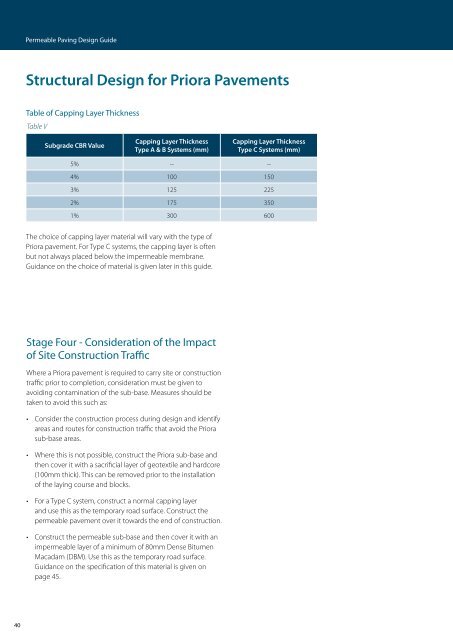Create successful ePaper yourself
Turn your PDF publications into a flip-book with our unique Google optimized e-Paper software.
40<br />
<strong>Permeable</strong> <strong>Paving</strong> <strong>Design</strong> <strong>Guide</strong><br />
Structural <strong>Design</strong> for Priora Pavements<br />
Table of Capping Layer Thickness<br />
Table V<br />
Subgrade CBR Value<br />
Capping Layer Thickness<br />
Type A & B Systems (mm)<br />
The choice of capping layer material will vary with the type of<br />
Priora pavement. For Type C systems, the capping layer is often<br />
but not always placed below the impermeable membrane.<br />
Guidance on the choice of material is given later in this guide.<br />
Capping Layer Thickness<br />
Type C Systems (mm)<br />
5% -- --<br />
4% 100 150<br />
3% 125 225<br />
2% 175 350<br />
1% 300 600<br />
Stage Four - Consideration of the Impact<br />
of Site Construction Traffic<br />
Where a Priora pavement is required to carry site or construction<br />
traffic prior to completion, consideration must be given to<br />
avoiding contamination of the sub-base. Measures should be<br />
taken to avoid this such as:<br />
• Consider the construction process during design and identify<br />
areas and routes for construction traffic that avoid the Priora<br />
sub-base areas.<br />
• Where this is not possible, construct the Priora sub-base and<br />
then cover it with a sacrificial layer of geotextile and hardcore<br />
(100mm thick). This can be removed prior to the installation<br />
of the laying course and blocks.<br />
• For a Type C system, construct a normal capping layer<br />
and use this as the temporary road surface. Construct the<br />
permeable pavement over it towards the end of construction.<br />
• Construct the permeable sub-base and then cover it with an<br />
impermeable layer of a minimum of 80mm Dense Bitumen<br />
Macadam (DBM). Use this as the temporary road surface.<br />
Guidance on the specification of this material is given on<br />
page 45.<br />
Hydraulic <strong>Design</strong> for Priora Pavements<br />
www.marshalls.co.uk/watermanagement<br />
Hydraulic requirements are frequently calculated using modelling software<br />
such as Micro Drainage's WinDes® (www.microdrainage.co.uk). These packages<br />
will take into account a wide range of rainfall frequencies and intensities as<br />
well as the topography of the site. The following provides the methodology<br />
behind arriving at a hydraulic calculation.<br />
The volume of water entering a Priora pavement is often greater<br />
than the water percolating into the subgrade or being slowly<br />
discharged to a secondary system. As such a degree of surface<br />
water storage will be required. The volume of water storage<br />
within a Priora pavement sub-base is calculated on the basis of:<br />
Water In – Water Out = Storage Volume Required<br />
The volume of water storage can be calculated using the<br />
Wallingford procedure and software packages are available to<br />
quickly and efficiently calculate for a variety of storm durations.<br />
The following tables can be used as a guide only to the sizing<br />
Table VI<br />
Sub-base Depth (mm)<br />
M5-60 r 1 in 30 year storm<br />
of the sub-base; they are conservative indications and more<br />
accurate (shallower) solutions can be calculated. The following is<br />
assumed in these tables:<br />
1. The Priora sub-base has a void ratio of 32%<br />
2. Discharge rate for types B and C systems are<br />
limited to 5 l/s/ha<br />
3. The Priora pavement has no impermeable area<br />
draining into it<br />
4. The site is level with no falls within the pavement<br />
1 in 100 year<br />
storm<br />
1 in 100 year<br />
storm + 30%<br />
20 0.4 120 160 210<br />
20 0.3 140 190 250<br />
20 0.2 180 250 330<br />
19 0.4 110 150 200<br />
19 0.3 130 180 230<br />
19 0.2 170 240 310<br />
18 0.4 100 140 180<br />
18 0.3 120 170 220<br />
18 0.2 160 220 290<br />
17 0.4 100 130 170<br />
17 0.3 110 160 210<br />
17 0.2 150 210 270<br />
16 0.4 100 120 160<br />
16 0.3 100 150 200<br />
16 0.2 140 200 260<br />
15 0.4 100 110 140<br />
15 0.3 100 140 180<br />
15 0.2 120 180 230<br />
14 0.4 100 100 130<br />
14 0.3 100 130 170<br />
14 0.2 110 170 220<br />
M5-60 is the anticipated rainfall for a storm of 60-minute duration that is likely to occur once in 5 years.<br />
“r” is the ration of a 60-minute to a 2 day rainfall depth for a 1 in 5 year storm return period.<br />
41



